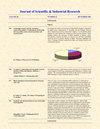Applications of Machine Learning Algorithms in Nitrogen Fertilizer Management of Triticale
IF 0.8
4区 工程技术
Q3 ENGINEERING, MULTIDISCIPLINARY
引用次数: 0
Abstract
In this study, a new classification technique is proposed to distinguish the appropriate one from four different nitrogen (N)fertilizer doses (0, 40, 80, and 160 kg ha−1) using six triticale cultivars. In the classification phase, nine yield featuresfrom 30 plants of the same cultivar were measured, that is, each dose or class has 30 feature vectors consisting of ninefeatures. Next, six triticale cultivars were classified for each dose of N fertilizer separately by using 30 feature vectorsbelonging to each dose. Similarly, the same classification task was repeated by using all feature vectors taken from fourdoses of N fertilizer. What makes this study novel is the classification process of six triticale cultivars by taking into accounttheir characters based on different doses of N fertilizer. The classification tasks were conducted by applying CommonVector Approach, Support Vector Machine, k-Nearest Neighbor, and Decision Trees algorithms. While satisfactory resultswere obtained from the training sets for all cases, the test set accuracy is relatively lower for the classification of four dosesof N fertilizer and six cultivars since features extracted from different doses of N fertilizer for the same cultivar are close toeach other. Furthermore, the number of feature vectors is insufficient to classify classes efficiently. Interestingly, when thecommon information of the classifiers was extracted with the biplot technique, useful results were obtained in selectingappropriate N doses for several triticale varieties. Combined with the results of future comprehensive studies, applicableresults for the agricultural sector can be proposed.机器学习算法在小黑麦氮肥管理中的应用
本研究以6个小黑麦品种为研究对象,提出了一种新的分类技术,以区分4种不同施氮量(0、40、80和160 kg ha - 1)的适宜施氮量。在分类阶段,测量同一品种30株的9个产量特征,即每个剂量或类别有30个特征向量,由9个特征组成。其次,利用各施氮量所属的30个特征向量,分别对6个小黑麦品种进行分类。同样,使用4个氮肥剂量的所有特征向量重复相同的分类任务。本研究的新颖之处在于根据不同施氮量对6个小黑麦品种的性状进行分类。采用CommonVector方法、支持向量机、k近邻和决策树算法进行分类。虽然所有情况下的训练集都获得了令人满意的结果,但由于从同一品种不同剂量的氮肥中提取的特征彼此接近,因此对于4种氮肥和6种品种的分类,测试集的准确性相对较低。此外,特征向量的数量不足以有效地分类。有趣的是,当用双图技术提取分类器的共同信息时,在几种小黑麦品种的适宜施氮量选择上获得了有用的结果。结合未来综合研究的结果,可以提出适用于农业部门的结果。
本文章由计算机程序翻译,如有差异,请以英文原文为准。
求助全文
约1分钟内获得全文
求助全文
来源期刊

Journal of Scientific & Industrial Research
工程技术-工程:综合
CiteScore
1.70
自引率
16.70%
发文量
99
审稿时长
4-8 weeks
期刊介绍:
This oldest journal of NISCAIR (started in 1942) carries comprehensive reviews in different fields of science & technology (S&T), including industry, original articles, short communications and case studies, on various facets of industrial development, industrial research, technology management, technology forecasting, instrumentation and analytical techniques, specially of direct relevance to industrial entrepreneurs, debates on key industrial issues, editorials/technical commentaries, reports on S&T conferences, extensive book reviews and various industry related announcements.It covers all facets of industrial development.
 求助内容:
求助内容: 应助结果提醒方式:
应助结果提醒方式:


